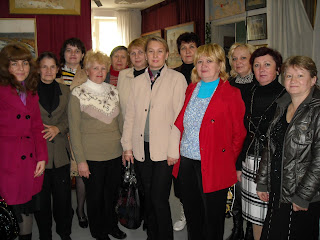One of the grants I am currently working on is a “Partnership Grant” through the Peace Corps, which is basically a way to raise funds in the United States for a project at a Volunteer’s site. Though Nadjie and I haven’t yet finalized plans for this grant, one of the projects we are considering is trying to raise funds to purchase copies of the Kadiaskerskie Books from the National Library of Russia in St. Petersburg. The Kadiaskerskie Books are the court records of the “chief judges” (the Kadi Asker) of the Crimean Khanate, which was the ruling body of Crimea from 1440-1783. They contain the most comprehensive historical record of Crimean Tatar life on the peninsula, including records of civil and criminal court proceedings, spiritual testimonies, the execution of wills, and the costs of public works and buildings.
The Kadiaskerskie Books have an interesting history. In 1738, a fire destroyed most of the Khan palace in Bakhchisaray, the capital of the Crimean Khanate. The Kadiaskerskie Books were long thought to be totally lost, but in fact, 119 books survived and were brought by an employee of the Khanate to the Tauride provincial government and stored in its archives. They languished in obscurity until 1905 when a famous Russian orientalist scholar, Vasily Smirnov (1846-1922), surveyed the Kadiaskerskie Books and recognized their historical importance. He recommended that they be transferred to the National Library of Russia in St. Petersburg for safe keeping, which is where they are today, despite several attempts to return them to their land of origin.
However, early photocopies of 61 of the Kadiaskerskie Books remain in Crimea, and even these have had a colorful history. Initially, they were housed in the Crimean History Museum. But one day, sometime after the Deportation of the Crimea Tatars, an employee of the nearby Crimean State Archives, Antonina Stepanova, stopped by the museum and realized that rare Crimean Tatar books, including copies of the Kadiaskerskie Books, were being used to stoke the boiler fire. She quickly ransomed the books with a bottle of vodka as payment, and took them to the State Archives for safe keeping. In late 1991, the question arose about sending the books back to the museum. However, they were rescued once again when a Crimean Tatar employee of the museum said, “Why send them back to a place where they suffered such a fate? Rather, they should go to the Gasprinskiy Library.” And so, the copies of the 61 Kadiaskerskie Books found a home in the Gasprinskiy Library where they are used to this day by researchers, scholars, and students of Crimean Tatar history and culture.
The copies of the Kadiaskerskie Books at the Gasprinskiy Library, covering the years 1648-1751.

The books are written in the Crimean Tatar language, using the Arabic alphabet.

However, these 61 books represent only a partial collection of the surviving Kadiaskerskie Books. One of the main missions of the Gasprinskiy Library is to be the central repository of books and documents by and about Crimean Tatars: a place where researchers, scholars, and the general public can come and learn about who the Crimean Tatar people are; a place where Crimean Tatar people can reclaim their history, language, and culture. To this end, a complete collection of copies of the Kadiaskerskie Books is crucial to fully understanding not only Crimean Tatar history and culture, but the history of the Crimean peninsula as a whole.
But of course, such a collection does not come without a price, and it is to fund this acquisition that we are considering the writing of a Partnership Grant. Currently, we are awaiting a reply from the St. Petersburg Library as to whether or not obtaining such copies is even possible, and if so, what the cost would be. I will post further information on this project as it develops.
Medine Alimova from the Archives Department at the Gasprinskiy Library holds one of the Kadiaskerskie Books.

Much of the information in this blog post is taken from an article written by Gasprinskiy librarian, Nadjie Tairova.















































